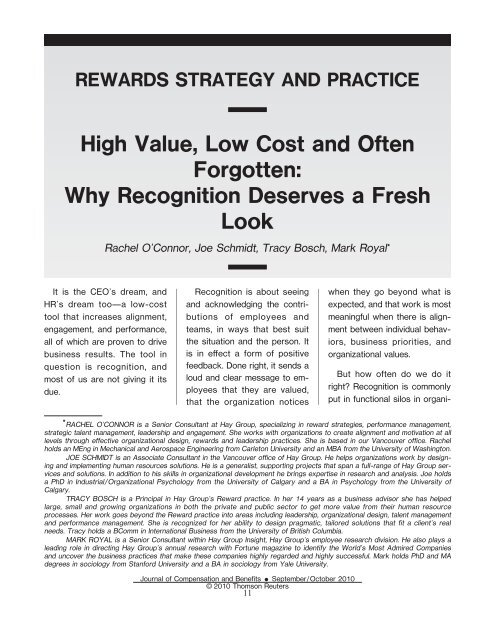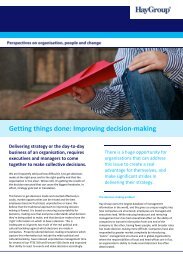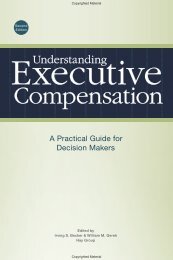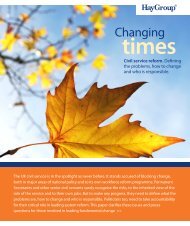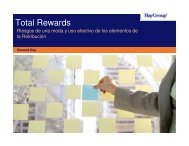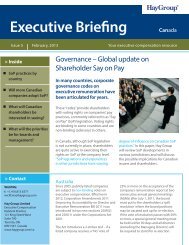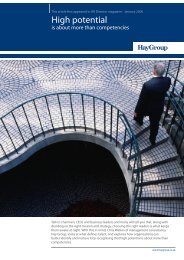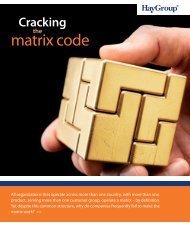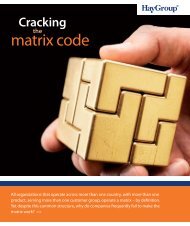read the full article from Journal of Compensation and ... - Hay Group
read the full article from Journal of Compensation and ... - Hay Group
read the full article from Journal of Compensation and ... - Hay Group
You also want an ePaper? Increase the reach of your titles
YUMPU automatically turns print PDFs into web optimized ePapers that Google loves.
REWARDS STRATEGY AND PRACTICE<br />
High Value, Low Cost <strong>and</strong> Often<br />
Forgotten:<br />
Why Recognition Deserves a Fresh<br />
Look<br />
Rachel O'Connor, Joe Schmidt, Tracy Bosch, Mark Royal *<br />
It is <strong>the</strong> CEO's dream, <strong>and</strong><br />
HR's dream too—a low-cost<br />
tool that increases alignment,<br />
engagement, <strong>and</strong> performance,<br />
all <strong>of</strong> which are proven to drive<br />
business results. The tool in<br />
question is recognition, <strong>and</strong><br />
most <strong>of</strong> us are not giving it its<br />
due.<br />
Recognition is about seeing<br />
<strong>and</strong> acknowledging <strong>the</strong> contributions<br />
<strong>of</strong> employees <strong>and</strong><br />
teams, in ways that best suit<br />
<strong>the</strong> situation <strong>and</strong> <strong>the</strong> person. It<br />
is in eect a form <strong>of</strong> positive<br />
feedback. Done right, it sends a<br />
loud <strong>and</strong> clear message to employees<br />
that <strong>the</strong>y are valued,<br />
that <strong>the</strong> organization notices<br />
when <strong>the</strong>y go beyond what is<br />
expected, <strong>and</strong> that work is most<br />
meaningful when <strong>the</strong>re is alignment<br />
between individual behaviors,<br />
business priorities, <strong>and</strong><br />
organizational values.<br />
But how <strong>of</strong>ten do we do it<br />
right? Recognition is commonly<br />
put in functional silos in organi-<br />
* RACHEL O'CONNOR is a Senior Consultant at <strong>Hay</strong> <strong>Group</strong>, specializing in reward strategies, performance management,<br />
strategic talent management, leadership <strong>and</strong> engagement. She works with organizations to create alignment <strong>and</strong> motivation at all<br />
levels through effective organizational design, rewards <strong>and</strong> leadership practices. She is based in our Vancouver <strong>of</strong>fice. Rachel<br />
holds an MEng in Mechanical <strong>and</strong> Aerospace Engineering <strong>from</strong> Carleton University <strong>and</strong> an MBA <strong>from</strong> <strong>the</strong> University <strong>of</strong> Washington.<br />
JOE SCHMIDT is an Associate Consultant in <strong>the</strong> Vancouver <strong>of</strong>fice <strong>of</strong> <strong>Hay</strong> <strong>Group</strong>. He helps organizations work by designing<br />
<strong>and</strong> implementing human resources solutions. He is a generalist, supporting projects that span a <strong>full</strong>-range <strong>of</strong> <strong>Hay</strong> <strong>Group</strong> services<br />
<strong>and</strong> solutions. In addition to his skills in organizational development he brings expertise in research <strong>and</strong> analysis. Joe holds<br />
a PhD in Industrial/Organizational Psychology <strong>from</strong> <strong>the</strong> University <strong>of</strong> Calgary <strong>and</strong> a BA in Psychology <strong>from</strong> <strong>the</strong> University <strong>of</strong><br />
Calgary.<br />
TRACY BOSCH is a Principal in <strong>Hay</strong> <strong>Group</strong>'s Reward practice. In her 14 years as a business advisor she has helped<br />
large, small <strong>and</strong> growing organizations in both <strong>the</strong> private <strong>and</strong> public sector to get more value <strong>from</strong> <strong>the</strong>ir human resource<br />
processes. Her work goes beyond <strong>the</strong> Reward practice into areas including leadership, organizational design, talent management<br />
<strong>and</strong> performance management. She is recognized for her ability to design pragmatic, tailored solutions that fit a client's real<br />
needs. Tracy holds a BComm in International Business <strong>from</strong> <strong>the</strong> University <strong>of</strong> British Columbia.<br />
MARK ROYAL is a Senior Consultant within <strong>Hay</strong> <strong>Group</strong> Insight, <strong>Hay</strong> <strong>Group</strong>'s employee research division. He also plays a<br />
leading role in directing <strong>Hay</strong> <strong>Group</strong>'s annual research with Fortune magazine to identify <strong>the</strong> World's Most Admired Companies<br />
<strong>and</strong> uncover <strong>the</strong> business practices that make <strong>the</strong>se companies highly regarded <strong>and</strong> highly successful. Mark holds PhD <strong>and</strong> MA<br />
degrees in sociology <strong>from</strong> Stanford University <strong>and</strong> a BA in sociology <strong>from</strong> Yale University.<br />
<strong>Journal</strong> <strong>of</strong> <strong>Compensation</strong> <strong>and</strong> Benets E September/October 2010<br />
© 2010 Thomson Reuters<br />
11
zations—assigned a place in<br />
Total Rewards, engagement,<br />
training <strong>and</strong> development, or<br />
performance management—<br />
ra<strong>the</strong>r than considered holistically,<br />
across <strong>the</strong> business. It is<br />
<strong>of</strong>ten treated as a program or a<br />
task ra<strong>the</strong>r than as part <strong>of</strong> <strong>the</strong><br />
organization's DNA or culture. It<br />
<strong>of</strong>ten takes <strong>the</strong> form <strong>of</strong> tokens<br />
<strong>and</strong> forced processes that are<br />
not strategically aligned with <strong>the</strong><br />
business.<br />
In practice, few organizations<br />
have recognition initiatives that<br />
are ring on all cylinders. Recognition<br />
is truly eective when<br />
it is:<br />
E Meaningful <strong>and</strong> tailored to<br />
<strong>the</strong> recipients<br />
E Aligned with <strong>and</strong> reinforcing<br />
<strong>the</strong> strategy, goals <strong>and</strong><br />
values <strong>of</strong> <strong>the</strong> organization<br />
E Well-delivered, sending<br />
<strong>the</strong> intended message<br />
In workplaces we use <strong>the</strong><br />
term recognition quite loosely,<br />
referring to anything <strong>from</strong><br />
length-<strong>of</strong>-service awards to<br />
pats on <strong>the</strong> back to bonus<br />
programs. In this <strong>article</strong>, our<br />
emphasis is on recognition with<br />
a low price tag, which would<br />
include both non-nancial recognition<br />
<strong>and</strong> small spot or token<br />
awards. We share insights <strong>from</strong><br />
current research that illuminate<br />
<strong>the</strong> role <strong>of</strong> recognition in engagement,<br />
alignment, <strong>and</strong> <strong>the</strong><br />
employee value proposition, <strong>and</strong><br />
<strong>Journal</strong> <strong>of</strong> <strong>Compensation</strong> <strong>and</strong> Benets<br />
we provide a framework <strong>and</strong><br />
tools for getting recognition to<br />
work for you.<br />
Recognition should not be<br />
considered just a warm-<strong>and</strong>fuzzy<br />
HR initiative. There is a<br />
real business case <strong>and</strong> economic<br />
value to be derived <strong>from</strong><br />
eective recognition programs.<br />
Most <strong>of</strong> us know intuitively <strong>the</strong><br />
importance <strong>of</strong> recognition <strong>and</strong><br />
<strong>the</strong> positive impact that wellcrafted<br />
recognition has on our<br />
commitment <strong>and</strong> motivation.<br />
The research bears this out <strong>and</strong><br />
draws a picture <strong>of</strong> a valuable<br />
<strong>and</strong> cost-eective tool, with<br />
non-nancial recognition outpacing<br />
even nancial incentives<br />
for driving job performance <strong>and</strong><br />
engagement.<br />
RECOGNITION AS A DRIVER<br />
OF ENGAGEMENT AND<br />
RETENTION<br />
<strong>Journal</strong> <strong>of</strong> <strong>Compensation</strong> <strong>and</strong> Benets E September/October 2010<br />
© 2010 Thomson Reuters<br />
12<br />
To keep <strong>and</strong> motivate <strong>the</strong>ir<br />
talent, many organizations are<br />
focusing attention on increasing<br />
levels <strong>of</strong> employee engagement.<br />
Engagement refers to <strong>the</strong> commitment<br />
employees feel toward<br />
<strong>the</strong> organization (e.g., <strong>the</strong>ir willingness<br />
to recommend it to<br />
friends <strong>and</strong> family, <strong>the</strong>ir pride in<br />
working for it <strong>and</strong> <strong>the</strong>ir intentions<br />
to remain a part <strong>of</strong> it). But<br />
it's also about employees' discretionary<br />
eort—<strong>the</strong>ir willingness<br />
to go <strong>the</strong> extra mile for <strong>the</strong><br />
organization. Right now, as organizations<br />
need to do more<br />
with less <strong>and</strong> strive for greater<br />
eciency, tapping into <strong>the</strong> discretionary<br />
eort <strong>of</strong> employees<br />
is all <strong>the</strong> more essential. And, in<br />
<strong>the</strong> rapidly changing environments<br />
most companies now<br />
face, where roles <strong>and</strong> responsibilities<br />
are continually evolving,<br />
organizations must count on<br />
employees to act on <strong>the</strong>ir own<br />
in ways consistent with organizational<br />
cultures, objectives,<br />
<strong>and</strong> values.<br />
Numerous studies have suggested<br />
that non-monetary rewards<br />
<strong>and</strong> recognition are very<br />
important motivators—sometimes<br />
more important nancial<br />
rewards. A meta-study that<br />
reviewed <strong>and</strong> syn<strong>the</strong>sized results<br />
<strong>from</strong> nearly all <strong>of</strong> <strong>the</strong> research<br />
conducted on nancial<br />
<strong>and</strong> non-nancial rewards over<br />
a 20 year period found that <strong>the</strong><br />
combination <strong>of</strong> performance<br />
feedback <strong>and</strong> recognition had<br />
substantially stronger eects on<br />
improving job performance than<br />
nancial rewards alone. 1<br />
It's not that money doesn't<br />
matter. It's just that money<br />
tends to be a “deciency need.”<br />
If employees feel that <strong>the</strong>y are<br />
signicantly underpaid—that<br />
<strong>the</strong>ir pay does not reect <strong>the</strong>ir<br />
contributions to <strong>the</strong> organization—<strong>the</strong>ir<br />
motivation is likely to<br />
suer. But when it comes to<br />
encouraging employees to pour<br />
discretionary eort into <strong>the</strong>ir<br />
work <strong>and</strong> delivering superior<br />
performance, <strong>the</strong> chance to<br />
make a dierence <strong>and</strong> be recognized<br />
for it is likely to provide
a much stronger incentive. As<br />
Harvard Business School pr<strong>of</strong>essor<br />
Rosabeth Moss Kanter<br />
puts it: “<strong>Compensation</strong> is a<br />
right. Recognition is a gift.”<br />
The fact that patting employees'<br />
backs may be a more effective<br />
form <strong>of</strong> positive motivation<br />
than padding <strong>the</strong>ir wallets<br />
is very good news for companies,<br />
especially in a challenging<br />
economy when nancial resources<br />
are stretched to <strong>the</strong><br />
limit. For unlike compensation,<br />
recognition is cheap. Indeed,<br />
<strong>of</strong>ten it's free. <strong>Hay</strong> <strong>Group</strong> employee<br />
opinion norms suggest,<br />
however, that too few organizations<br />
are leveraging <strong>the</strong> motivational<br />
power <strong>of</strong> non-monetary<br />
rewards. Only 57% <strong>of</strong> nonmanagement<br />
employees, <strong>and</strong><br />
just 63% <strong>of</strong> managers, report<br />
that <strong>the</strong>ir contributions are typically<br />
recognized when <strong>the</strong>y perform<br />
well.<br />
Indeed, in engagementrelated<br />
research <strong>Hay</strong> <strong>Group</strong><br />
conducted in partnership with<br />
WorldatWork <strong>and</strong> Loyola University<br />
Chicago in 2010, fewer<br />
than 40% <strong>of</strong> reward pr<strong>of</strong>essionals<br />
surveyed rated non-nancial<br />
recognition as having a “high”<br />
or “very high” impact on employee<br />
engagement levels.<br />
These results would seem to<br />
Rewards Strategy <strong>and</strong> Practice<br />
conrm a gap between <strong>the</strong> motivational<br />
potential <strong>of</strong> recognition<br />
programs <strong>and</strong> current<br />
practice.<br />
As our world <strong>of</strong> work continues<br />
to evolve, recognition will<br />
only become more important. In<br />
tough economic times, when an<br />
organization's nancial resources<br />
are constrained, a focus<br />
on non-nancial recognition<br />
is even more essential. As we<br />
turn a spotlight on generational<br />
dierences in <strong>the</strong> workplace,<br />
recognition shows up as a priority<br />
in <strong>the</strong> employee value<br />
proposition. In fact, <strong>Hay</strong> <strong>Group</strong>'s<br />
employee engagement research<br />
has shown that respect <strong>and</strong><br />
recognition are extremely important<br />
components <strong>of</strong> <strong>the</strong> employment<br />
value proposition for<br />
younger employees. Respect<br />
<strong>and</strong> recognition ranks as <strong>the</strong><br />
rst <strong>and</strong> second most important<br />
driver <strong>of</strong> engagement for Millennials<br />
<strong>and</strong> Generation X,<br />
respectively. Scottrade recognizes<br />
<strong>the</strong> importance <strong>of</strong> recognition<br />
for younger workers. As<br />
Jane Wulf, executive director <strong>of</strong><br />
human resources, notes, “<strong>the</strong>y<br />
grew up with bumper stickers<br />
on <strong>the</strong>ir cars saying, ‘My child<br />
is an honor student.’ They grew<br />
up in an era where everyone<br />
won a trophy.” 2<br />
Now more than ever, recognition<br />
is important. It quite simply<br />
gets <strong>the</strong> job done. So how<br />
do you make it work for you?<br />
A FRAMEWORK FOR<br />
RECOGNITION PROGRAM<br />
DESIGN<br />
We nd that when organizations<br />
are designing recognition<br />
programs, <strong>the</strong> conversation <strong>of</strong>ten<br />
begins <strong>and</strong> ends with what<br />
<strong>the</strong> program will look like <strong>and</strong><br />
how it will work, ra<strong>the</strong>r than<br />
why it exists <strong>and</strong> what results it<br />
is intended to achieve. For example,<br />
organizations will decide<br />
to create a length <strong>of</strong> service<br />
recognition program <strong>and</strong> focus<br />
on milestones, sizes <strong>of</strong> gifts,<br />
<strong>and</strong> o<strong>the</strong>r details, instead <strong>of</strong><br />
beginning with a discussion <strong>of</strong><br />
how such a program returns<br />
value to <strong>the</strong> organization <strong>and</strong><br />
employees <strong>and</strong> what strategic<br />
drivers might inuence design.<br />
The framework outlined below<br />
illustrates an approach to<br />
mindful <strong>and</strong> strategic recognition<br />
program development. In<br />
practice, <strong>the</strong> design process<br />
does not need to be any heavier<br />
or more complex, but <strong>the</strong> approach<br />
going in needs to focus<br />
on how to achieve a good return<br />
on <strong>the</strong> nancial <strong>and</strong> emotional<br />
investment in recognition.<br />
<strong>Journal</strong> <strong>of</strong> <strong>Compensation</strong> <strong>and</strong> Benets E September/October 2010<br />
© 2010 Thomson Reuters<br />
13
<strong>Journal</strong> <strong>of</strong> <strong>Compensation</strong> <strong>and</strong> Benets<br />
Rewards, whe<strong>the</strong>r tangible or<br />
intangible, are a tool for increasing<br />
organizational eectiveness.<br />
The employment relationship<br />
involves an exchange <strong>of</strong> organizational<br />
inducements for employee<br />
contributions. A well<br />
designed program focuses<br />
those inducements to attract<br />
<strong>and</strong> retain <strong>the</strong> talent <strong>the</strong> organization<br />
requires <strong>and</strong> motivate<br />
employees to act in ways consistent<br />
with business objectives.<br />
Accordingly, your recognition<br />
approach should be designed<br />
to balance <strong>the</strong> needs <strong>of</strong> <strong>the</strong> organization<br />
<strong>and</strong> <strong>the</strong> needs <strong>of</strong><br />
employees.<br />
BEGINNING WITH STRATEGY<br />
AND ENDING WITH RESULTS<br />
It should go without saying<br />
that any investment <strong>of</strong> an organization's<br />
resources should be<br />
done with an eye to <strong>the</strong> strategy,<br />
goals, culture, <strong>and</strong> values<br />
<strong>of</strong> <strong>the</strong> organization. As discussed<br />
above, recognition program<br />
design or review should<br />
begin with an underst<strong>and</strong>ing <strong>of</strong><br />
what <strong>the</strong> program is intended to<br />
support. Often <strong>the</strong> intermediary<br />
between <strong>the</strong> business strategy<br />
<strong>of</strong> <strong>the</strong> organization <strong>and</strong> <strong>the</strong> strategic<br />
objectives <strong>of</strong> a specic<br />
program area, such as recognition,<br />
is a human capital strategy<br />
that looks holistically at <strong>the</strong><br />
programs that will ensure <strong>the</strong><br />
organization has <strong>the</strong> talent, systems,<br />
<strong>and</strong> resources required<br />
<strong>Journal</strong> <strong>of</strong> <strong>Compensation</strong> <strong>and</strong> Benets E September/October 2010<br />
© 2010 Thomson Reuters<br />
14<br />
to achieve its overall business<br />
strategy.<br />
Positioning recognition within<br />
a human capital strategy, as<br />
opposed to a more narrow reward<br />
strategy, makes us better<br />
able to deliver <strong>the</strong> business<br />
benets <strong>of</strong> recognition. When<br />
done well, recognition is a form<br />
<strong>of</strong> feedback that tells us we are<br />
doing something that is contributing<br />
to <strong>the</strong> organization's<br />
success. Recognition communicates<br />
messages about <strong>the</strong> contributions<br />
that are expected <strong>and</strong><br />
valued by <strong>the</strong> organization.<br />
From this perspective, recognition<br />
is a key tool for aligning<br />
employees with team <strong>and</strong> organizational<br />
goals. It takes place,<br />
both formally <strong>and</strong> informally, in<br />
<strong>the</strong> context <strong>of</strong> performance
management <strong>and</strong> day-to-day<br />
coaching <strong>and</strong> leadership. When<br />
we integrate recognition with<br />
performance management <strong>and</strong><br />
leadership programs, it puts <strong>the</strong><br />
organization in a better position<br />
to deliver <strong>the</strong> value <strong>of</strong> recognition<br />
to both <strong>the</strong> employee <strong>and</strong><br />
<strong>the</strong> employer.<br />
The nal key element <strong>of</strong> <strong>the</strong><br />
recognition framework relates<br />
to <strong>the</strong> results you expect to<br />
see—<strong>the</strong> ultimate output <strong>of</strong><br />
strategy execution. To assess<br />
<strong>the</strong> ROI <strong>of</strong> strategic initiatives,<br />
including human capital strategies,<br />
it is necessary to document<br />
how <strong>the</strong> program will deliver<br />
value at <strong>the</strong> beginning <strong>of</strong><br />
<strong>the</strong> design process. For larger<br />
investments, this might include<br />
identifying measures <strong>of</strong> success<br />
<strong>and</strong> implementing processes to<br />
track those measures. Between<br />
<strong>the</strong> design <strong>and</strong> <strong>the</strong> results you<br />
will need to consider implementation<br />
as well—how to make <strong>the</strong><br />
change happen <strong>and</strong> <strong>the</strong> results<br />
real.<br />
CONSIDERING THE NEEDS<br />
OF THE EMPLOYEE AND THE<br />
NEEDS OF THE<br />
ORGANIZATION<br />
As we work through our<br />
framework, we next need to<br />
consider how to optimize our<br />
program design <strong>and</strong> execution<br />
to align with <strong>the</strong> needs <strong>of</strong> employees<br />
<strong>and</strong> <strong>the</strong> organization.<br />
For employees, it needs to be<br />
more than a one-o program. It<br />
needs to be meaningful. For <strong>the</strong><br />
Rewards Strategy <strong>and</strong> Practice<br />
employer, recognition programs<br />
should deliver real business<br />
benet. They should motivate<br />
discretionary eort <strong>and</strong> performance<br />
that is aligned with organizational<br />
goals.<br />
The social contract between<br />
employers <strong>and</strong> employees is<br />
changing. Employee expectations<br />
extend beyond nancial<br />
rewards into important intangibles<br />
such as pr<strong>of</strong>essional<br />
development, career progression,<br />
work-life balance, <strong>and</strong> <strong>the</strong><br />
opportunity to contribute to<br />
something larger than<br />
<strong>the</strong>mselves. Recognition needs<br />
to t into that wider social contract<br />
<strong>and</strong> form part <strong>of</strong> that employee<br />
value proposition that<br />
delineates what an organization<br />
can oer to its people.<br />
Aside <strong>from</strong> generational differences,<br />
we know that what<br />
motivates people intrinsically<br />
can vary widely. Managers face<br />
signicant challenges trying to<br />
underst<strong>and</strong> what makes employees<br />
tick in order to recognize<br />
employees appropriately.<br />
The social motive framework,<br />
as popularized by renowned<br />
psychologist David McClell<strong>and</strong>,<br />
is a straightforward tool that<br />
managers can use to identify<br />
<strong>the</strong> types <strong>of</strong> recognition that different<br />
employees nd<br />
motivating. 3 There are three basic<br />
social motives:<br />
1. Need for Achievement (<strong>the</strong><br />
motivation to master<br />
<strong>Journal</strong> <strong>of</strong> <strong>Compensation</strong> <strong>and</strong> Benets E September/October 2010<br />
© 2010 Thomson Reuters<br />
15<br />
tasks, achieve high st<strong>and</strong>ards<br />
<strong>of</strong> performance, <strong>and</strong><br />
outperform o<strong>the</strong>rs);<br />
2. Need for Power (<strong>the</strong> motivation<br />
to inuence o<strong>the</strong>rs,<br />
shape <strong>the</strong> environment,<br />
<strong>and</strong> eect social change);<br />
<strong>and</strong><br />
3. Need for Aliation (<strong>the</strong><br />
motivation to belong <strong>and</strong><br />
feel accepted in a social<br />
group).<br />
Any one <strong>of</strong> <strong>the</strong>se social motives<br />
can inuence a person's<br />
behavior in a given situation,<br />
<strong>and</strong> most <strong>of</strong> us have some element<br />
<strong>of</strong> each. However, individuals<br />
frequently have a dominant<br />
motive. Astute managers<br />
can gain a good underst<strong>and</strong>ing<br />
<strong>of</strong> <strong>the</strong>ir direct reports' dominant<br />
motives <strong>and</strong> provide recognition<br />
accordingly.<br />
For example, recognition in<br />
<strong>the</strong> form <strong>of</strong> status <strong>and</strong> challenging<br />
assignments can be an effective<br />
motivator for those high<br />
in Need for Achievement: a public<br />
thank-you, preferred parking,<br />
employee <strong>of</strong> <strong>the</strong> month<br />
programs, individual performance<br />
ratings or <strong>the</strong> opportunity<br />
to work on a special<br />
project. For o<strong>the</strong>rs, this type <strong>of</strong><br />
public recognition can be<br />
demotivational. Team lunches,<br />
team measures <strong>of</strong> achievement,<br />
<strong>and</strong> heart-felt thank you cards<br />
will motivate employees high in<br />
Need for Aliation, but those<br />
forms <strong>of</strong> recognition can be an
<strong>Journal</strong> <strong>of</strong> <strong>Compensation</strong> <strong>and</strong> Benets<br />
annoyance to employees with a<br />
high Power motive. These employees<br />
likely need to be recognized<br />
with opportunities to<br />
implement a new project, lead a<br />
team, measure <strong>the</strong> impact <strong>of</strong><br />
<strong>the</strong>ir work outside <strong>the</strong> organization,<br />
or network with senior<br />
management. Although people<br />
are extremely complex <strong>and</strong> employee<br />
behavior cannot be easily<br />
cast into three broad categories,<br />
managers who hone<br />
<strong>the</strong>ir skills at identifying employees'<br />
dominant motive proles<br />
will be much more eective at<br />
providing powerful <strong>and</strong> engaging<br />
recognition.<br />
MAXIMIZING RECOGNITION<br />
ROI IN PRACTICE<br />
The evidence supports recognition<br />
as an important driver<br />
<strong>of</strong> engagement, retention, <strong>and</strong><br />
business performance, but what<br />
does this look like in practice?<br />
How do we foster a culture <strong>of</strong><br />
recognition throughout <strong>the</strong> organization,<br />
while simultaneously<br />
enabling managers to help employees<br />
feel valued <strong>and</strong> motivated<br />
to provide discretionary<br />
eort? In this section we will<br />
discuss four key factors <strong>of</strong> effective<br />
recognition practices.<br />
These factors are:<br />
1. Underst<strong>and</strong>ing recognition<br />
outcomes;<br />
2. Using multiple levels <strong>of</strong> interaction;<br />
3. Creating a culture <strong>of</strong> recognition;<br />
<strong>and</strong><br />
4. Delivering eective recognition—<strong>the</strong><br />
PRAISE model.<br />
We will conclude by outlining<br />
specic recognition practices<br />
that, with very little nancial<br />
investment, can produce substantial<br />
returns in employee<br />
performance <strong>and</strong> commitment.<br />
DIFFERENT TYPES OF<br />
RECOGNITION PRODUCE<br />
DIFFERENT OUTCOMES<br />
Underst<strong>and</strong>ing that recognition<br />
is a powerful, but <strong>of</strong>ten<br />
ineectively applied, motivator<br />
is an important rst step. For<br />
recognition eorts to be truly<br />
engaging, however, managers<br />
must align <strong>the</strong>ir recognition<br />
practices with <strong>the</strong> outcomes<br />
<strong>the</strong>y hope to achieve. Tables 1<br />
<strong>and</strong> 2 organize dierent recognition<br />
practices according to<br />
<strong>the</strong>ir association with four important<br />
outcomes, as well as by<br />
dierent levels <strong>of</strong> interaction. 4<br />
Table 1. Outcomes <strong>of</strong> Recognition<br />
Valuing People <strong>and</strong><br />
<strong>Group</strong>s<br />
Outcomes, E Foster teamwork<br />
value <strong>and</strong> <strong>and</strong> employees'<br />
role<br />
sense <strong>of</strong> belonging to<br />
group or organization<br />
E Show interest in<br />
<strong>the</strong> person for <strong>the</strong>mselves,<br />
not just <strong>the</strong>ir<br />
work<br />
E Can contribute to<br />
engagement <strong>and</strong> also<br />
values alignment in<br />
particular; less <strong>of</strong> a<br />
direct link to driving<br />
results<br />
Reinforcing Actions<br />
<strong>and</strong> Practices<br />
E Positively reinforce<br />
employee development,<br />
problem-solving,<br />
good process <strong>and</strong><br />
practices, innovation<br />
E Reinforces <strong>the</strong> values<br />
<strong>and</strong> culture <strong>of</strong> <strong>the</strong><br />
organization as well<br />
as <strong>the</strong> ways <strong>of</strong> getting<br />
work done; indirect<br />
link to results<br />
Crediting Eort<br />
<strong>and</strong> Commitment<br />
E Shows awareness<br />
<strong>of</strong> an appreciation<br />
for dedication,<br />
eort, drive<br />
<strong>and</strong> loyalty<br />
E Contributes to<br />
dedication, engagement,<br />
retention <strong>and</strong><br />
sustained eort <strong>and</strong><br />
motivation<br />
Applauding Peformance<br />
<strong>and</strong> Results<br />
Highlights achievements,<br />
work product<br />
<strong>and</strong> results<br />
E Enhances performance,<br />
maintaining<br />
focus on results <strong>and</strong><br />
contributing strongly to<br />
alignment <strong>and</strong> drive<br />
The rst outcome is about<br />
fostering teamwork <strong>and</strong> employees'<br />
sense <strong>of</strong> belonging to<br />
<strong>the</strong> group or organization. This<br />
is an ethical aspect <strong>of</strong> recognition—valuing<br />
employees as individuals<br />
because it is <strong>the</strong> right<br />
thing to do—<strong>and</strong> it can have<br />
important eects on organizational<br />
commitment. Extensive<br />
research has indicated that employees<br />
are less likely to leave<br />
<strong>Journal</strong> <strong>of</strong> <strong>Compensation</strong> <strong>and</strong> Benets E September/October 2010<br />
© 2010 Thomson Reuters<br />
16
<strong>the</strong> organization if <strong>the</strong>y feel <strong>the</strong>y<br />
have been treated fairly 5 <strong>and</strong> if<br />
<strong>the</strong>y feel attached to <strong>the</strong> team<br />
or organization. 6 Examples <strong>of</strong><br />
recognition associated with<br />
teamwork <strong>and</strong> belongingness<br />
include:<br />
E Organizing social ga<strong>the</strong>rings<br />
for employees<br />
E Management providing<br />
coaching <strong>and</strong> feedback for<br />
employee development<br />
E Recognizing important life<br />
events (birthdays, completing<br />
a training course,<br />
etc.)<br />
The second outcome category<br />
relates to employee development,<br />
problem-solving, <strong>and</strong><br />
innovation. Focusing on recognition<br />
practices associated with<br />
<strong>the</strong>se outcomes is important for<br />
organizations looking to alter<br />
<strong>the</strong>ir strategic direction or to<br />
develop innovative products<br />
<strong>and</strong> work processes. This type<br />
<strong>of</strong> recognition may occur after<br />
employees have identied quality<br />
improvements, demonstrated<br />
creative thinking, or obtained<br />
skills aligned with <strong>the</strong> organization's<br />
new strategic direction.<br />
Some examples include:<br />
E Highlighting innovation <strong>and</strong><br />
creative thinking at team<br />
meetings<br />
E Providing assignments to<br />
special process improvement<br />
projects<br />
Rewards Strategy <strong>and</strong> Practice<br />
E Implementing pr<strong>of</strong>essional<br />
practice or innovation<br />
award programs<br />
Job dedication <strong>and</strong> organizational<br />
commitment are outcomes<br />
relating to <strong>the</strong> third recognition<br />
practice category. This<br />
type <strong>of</strong> recognition is provided<br />
after employees have demonstrated<br />
considerable eort during<br />
a dem<strong>and</strong>ing period or remained<br />
positive <strong>and</strong> supportive<br />
in a time <strong>of</strong> organizational<br />
change. These recognition<br />
practices may alleviate job<br />
burnout <strong>and</strong> fur<strong>the</strong>r enhance<br />
organizational commitment as<br />
employees perceive that <strong>the</strong>ir<br />
eorts were valued. Some examples<br />
<strong>of</strong> recognition associated<br />
with this outcome include:<br />
E Providing personalized letters<br />
acknowledging employee<br />
contributions during<br />
a dicult time<br />
E Explicitly accounting for<br />
situational constraints <strong>and</strong><br />
diculty <strong>of</strong> work during<br />
performance evaluations<br />
E Recognizing overtime<br />
<strong>Journal</strong> <strong>of</strong> <strong>Compensation</strong> <strong>and</strong> Benets E September/October 2010<br />
© 2010 Thomson Reuters<br />
17<br />
Performance is <strong>the</strong> outcome<br />
<strong>of</strong> <strong>the</strong> nal recognition practice<br />
category. Recognition enhances<br />
performance when it is provided<br />
to employees who have<br />
achieved explicit outcomes valued<br />
by <strong>the</strong> organization. It helps<br />
align behaviour <strong>and</strong> ensures<br />
everyone is pulling in <strong>the</strong> same<br />
direction to attain <strong>the</strong> organization's<br />
strategic imperatives.<br />
Some <strong>of</strong> <strong>the</strong>se types <strong>of</strong> recognition<br />
practices include:<br />
E Parties to celebrate team<br />
success<br />
E Bonus incentives<br />
E Awards <strong>of</strong> excellence<br />
When managers <strong>and</strong> organizations<br />
focus on achieving all<br />
four recognition outcomes, <strong>the</strong><br />
message sent to employees is:<br />
“Your perspectives <strong>and</strong> skills<br />
are valued, you are enabled to<br />
make improvements, your eort<br />
<strong>and</strong> sacrice has been noticed,<br />
<strong>and</strong> you will be appropriately<br />
<strong>and</strong> expediently rewarded for<br />
delivering results.” This simple<br />
statement touches on many<br />
important aspects <strong>of</strong> prominent<br />
work motivation <strong>the</strong>ories that<br />
have been shown predict superior<br />
performance <strong>and</strong> job<br />
dedication. 7<br />
WORKING WITH A FULL<br />
TOOLKIT: LEVELS OF<br />
INTERACTION<br />
In addition to organizing recognition<br />
practices by <strong>the</strong> four<br />
major outcome areas, Table 2<br />
clusters recognition practices<br />
according to <strong>the</strong> target <strong>of</strong> <strong>the</strong><br />
recognition message—o<strong>the</strong>rwise<br />
known as levels <strong>of</strong><br />
interaction. This model underscores<br />
<strong>the</strong> value <strong>of</strong> multi-level<br />
recognition practices (peer,<br />
manager, <strong>and</strong> organizational) to<br />
instill a culture <strong>of</strong> recognition<br />
throughout <strong>the</strong> organization. It
<strong>Journal</strong> <strong>of</strong> <strong>Compensation</strong> <strong>and</strong> Benets<br />
also represents an underst<strong>and</strong>ing<br />
that organizations do not<br />
operate in isolation <strong>and</strong> require<br />
motivated suppliers, partners,<br />
<strong>and</strong> subcontractors, as well as<br />
community support, in order to<br />
function eectively. As such,<br />
<strong>the</strong> model fur<strong>the</strong>r delineates<br />
practices aimed at providing<br />
recognition to external stakeholders<br />
<strong>and</strong> <strong>the</strong> community at<br />
large.This is about awareness<br />
that recognition can come <strong>from</strong><br />
peers <strong>and</strong> teammates, management<br />
<strong>and</strong> leadership, <strong>the</strong> organization,<br />
or even individuals <strong>and</strong><br />
groups outside <strong>the</strong> organization.<br />
Using strategies at dierent<br />
levels <strong>of</strong> interaction maximizes<br />
impact as it increases <strong>the</strong><br />
sources <strong>and</strong> freshness <strong>of</strong><br />
recognition. It also helps us<br />
meet dierent need based on<br />
generational dierences <strong>and</strong><br />
motivations.<br />
An eective recognition strategy<br />
has elements throughout<br />
this matrix, touching on each<br />
outcome <strong>and</strong> each level <strong>of</strong><br />
interaction. This helps ensure<br />
messages are well-balanced,<br />
so that <strong>the</strong>y do not reinforce<br />
one element at <strong>the</strong> expense <strong>of</strong><br />
ano<strong>the</strong>r. It also helps ensure<br />
that recognition works for different<br />
people, taking into consideration<br />
how <strong>the</strong>y are motivated<br />
<strong>and</strong> what <strong>the</strong>ir<br />
preferences are.<br />
Table 2. Examples <strong>of</strong> recognition for dierent levels <strong>of</strong> interaction within each outcome<br />
Level <strong>of</strong> Interaction<br />
Horizontal recognition:<br />
Peers, teammates<br />
<strong>and</strong> colleagues<br />
Vertical recognition:<br />
Management<br />
<strong>and</strong> leadership<br />
Valuing People<br />
<strong>and</strong> <strong>Group</strong>s<br />
E Seeking advice<br />
or input <strong>from</strong> a<br />
peer<br />
E Team events to<br />
build relationships<br />
within a team<br />
E Being available<br />
<strong>and</strong> visible to team<br />
members<br />
E Providing exibility<br />
E Creating pr<strong>of</strong>essional<br />
development<br />
opportunities<br />
Reinforcing Actions<br />
<strong>and</strong> Practices<br />
E Requesting mentorship<br />
or training<br />
<strong>from</strong> a peer<br />
E Providing feedback<br />
or recognition<br />
to a peer for a pr<strong>of</strong>essional<br />
skill<br />
E Assigning special<br />
projects<br />
E Asking an individual<br />
to train o<strong>the</strong>rs<br />
E Recognizing a<br />
team for role modeling<br />
for an organizational<br />
value<br />
Crediting Eort <strong>and</strong><br />
Commitment<br />
E Oering peer support<br />
to a teammate<br />
during <strong>the</strong>ir crunch<br />
period<br />
E Bringing a colleague<br />
a coee or<br />
lunch<br />
Showing awareness<br />
<strong>of</strong> eort <strong>and</strong> complexity<br />
<strong>of</strong> work when<br />
reviewing performance<br />
<strong>and</strong> results<br />
E Having a social<br />
event after a crunch<br />
period<br />
Applauding Peformance<br />
<strong>and</strong> Results<br />
E Celebrating a success<br />
toge<strong>the</strong>r as a<br />
team<br />
E Personally congratulating<br />
a colleague<br />
when a milestone<br />
is achieved<br />
Investing time in<br />
high-quality performance<br />
conversations<br />
<strong>and</strong> reviews<br />
E Holding people<br />
accountable<br />
E Writing personal<br />
letters <strong>of</strong> recognition<br />
for results<br />
E Sharing team successes<br />
with own<br />
manager<br />
<strong>Journal</strong> <strong>of</strong> <strong>Compensation</strong> <strong>and</strong> Benets E September/October 2010<br />
© 2010 Thomson Reuters<br />
18
Rewards Strategy <strong>and</strong> Practice<br />
Level <strong>of</strong> Interaction<br />
Organizational recognition<br />
External recognition:<br />
community,<br />
suppliers, clients,<br />
associations, partners<br />
Valuing People<br />
<strong>and</strong> <strong>Group</strong>s<br />
E Orientation for<br />
new employees,<br />
addressing more<br />
than task/ process<br />
E Soliciting employee<br />
input<br />
E Creating transparent<br />
processes<br />
E Cards for life<br />
events<br />
E Support for individual<br />
volunteer<br />
work or corporate<br />
social responsibility<br />
E Family events<br />
E Programs to collect<br />
feedback <strong>from</strong><br />
clients or suppliers<br />
E Positive <strong>and</strong> respected<br />
employer<br />
br<strong>and</strong><br />
Reinforcing Actions<br />
<strong>and</strong> Practices<br />
E Supporting pr<strong>of</strong>essional<br />
development<br />
E Recognizing process<br />
improvement<br />
<strong>and</strong> innovation<br />
E Performance reviews<br />
that include<br />
measures <strong>of</strong> collaboration<br />
<strong>and</strong> teamwork<br />
E Participation in<br />
external st<strong>and</strong>ards<br />
programs at <strong>the</strong> organizational<br />
level<br />
E Recognition for<br />
pr<strong>of</strong>essional certications<br />
relating to<br />
practices, processes<br />
<strong>and</strong> ethical st<strong>and</strong>ards<br />
E Partnerships with<br />
community organizations<br />
Crediting Eort <strong>and</strong><br />
Commitment<br />
E Recognition for<br />
years <strong>of</strong> service<br />
<strong>and</strong>/or overtime<br />
E Providing support<br />
for oce social activities<br />
E Providing exibility<br />
in work arrangements<br />
to oset dem<strong>and</strong>s<br />
<strong>of</strong> work<br />
Showcasing client<br />
experiences where a<br />
team or employee<br />
went above <strong>and</strong> beyond<br />
<strong>the</strong> call <strong>of</strong> duty<br />
E Sharing <strong>the</strong> energy<br />
<strong>and</strong> dedication <strong>of</strong><br />
employees with <strong>the</strong><br />
community through<br />
team volunteer programs<br />
Applauding Peformance<br />
<strong>and</strong> Results<br />
Eective processes<br />
for performance<br />
management <strong>and</strong><br />
accountability<br />
E Programs with<br />
gifts to recognize<br />
goal or milestone<br />
achievements<br />
E Award programs<br />
E Discretionary recognition<br />
budgets<br />
E Personalized congratulations<br />
<strong>from</strong><br />
CEO<br />
Proling in “best<br />
companies” lists<br />
E Media coverage<br />
for signicant milestones<br />
E Showcasing team<br />
results in annual reports<br />
to investors or<br />
<strong>the</strong> community<br />
CREATING A CULTURE OF<br />
RECOGNITION<br />
For recognition to be truly effective,<br />
it must be ingrained in<br />
an organization's culture or<br />
DNA. If recognition is perceived<br />
as “ano<strong>the</strong>r HR initiative” or as<br />
solely a managerial accountability,<br />
it is unlikely to produce<br />
any substantive ROI. When recognition<br />
is eectively delivered<br />
by peers, managers, <strong>and</strong> external<br />
stakeholders, <strong>and</strong> supported<br />
by organizational processes, it<br />
is ingrained within <strong>the</strong> organization's<br />
culture <strong>and</strong> can have a<br />
pr<strong>of</strong>ound impact.<br />
Changing <strong>the</strong> culture <strong>of</strong> an<br />
organization to build recognition<br />
into its fabric can be a<br />
challenge. The rst step is to<br />
create organizational processes<br />
designed to support recognition<br />
eorts at all levels <strong>of</strong> interaction,<br />
not just <strong>the</strong> organizational<br />
level. For example, organizations<br />
might measure <strong>and</strong> reward<br />
managers for <strong>the</strong>ir skill in recognition,<br />
or implement a corporate<br />
social responsibility program<br />
that gives <strong>the</strong> organization<br />
<strong>Journal</strong> <strong>of</strong> <strong>Compensation</strong> <strong>and</strong> Benets E September/October 2010<br />
© 2010 Thomson Reuters<br />
19<br />
<strong>the</strong> ties to its community that<br />
might foster external<br />
recognition.<br />
The next step is to implement<br />
programs designed to develop<br />
employees' skills in delivering<br />
eective recognition. The implementation<br />
process should cascade<br />
<strong>from</strong> <strong>the</strong> management levels<br />
down through individual<br />
contributors <strong>and</strong> emphasize <strong>the</strong><br />
business value <strong>of</strong> recognition,<br />
<strong>the</strong> outcomes <strong>of</strong> dierent recognition<br />
practices, <strong>and</strong> that recognition<br />
is everyone's<br />
responsibility.
<strong>Journal</strong> <strong>of</strong> <strong>Compensation</strong> <strong>and</strong> Benets<br />
Although <strong>the</strong>se steps are<br />
foundational to developing a<br />
recognition culture, nothing will<br />
change if people do not deliver<br />
recognition eectively. The next<br />
section describes a framework<br />
to provide eective recognition<br />
to o<strong>the</strong>rs.<br />
DELIVERING EFFECTIVE<br />
RECOGNITION—THE PRAISE<br />
MODEL<br />
At <strong>the</strong> end <strong>of</strong> <strong>the</strong> day, recognition<br />
is not about <strong>the</strong> mug or<br />
plaque or coee card. The most<br />
important aspect <strong>of</strong> recognition<br />
is <strong>the</strong> message. If <strong>the</strong> message<br />
is underscored by <strong>and</strong> reinforced<br />
with a gift, that can help<br />
give it weight <strong>and</strong> make it memorable;<br />
but a gift without underlying<br />
meaning <strong>and</strong> a welldelivered<br />
message is wasted.<br />
So how best to deliver <strong>the</strong><br />
message? Since recognition is<br />
feedback, most models for positive<br />
constructive feedback apply<br />
here. We outline below one<br />
model that we use when developing<br />
recognition skills for<br />
managers: <strong>the</strong> PRAISE model.<br />
Personal<br />
Relevant<br />
Articulate<br />
In Time<br />
Specic<br />
Engaging<br />
Know <strong>the</strong> individual <strong>and</strong> tailor <strong>the</strong> message to <strong>the</strong>m (refer to <strong>the</strong> discussion <strong>of</strong> social<br />
motives in a previous section)<br />
Recognize worthwhile things <strong>and</strong> link recognition to goals <strong>and</strong> values<br />
Keep it clear <strong>and</strong> concise<br />
Don't wait; recognize as close to <strong>the</strong> event or behaviour as you can<br />
Explain exactly what was well done <strong>and</strong> why you are recognizing it<br />
Be sincere, build rapport, <strong>and</strong> use <strong>the</strong> opportunity you are creating to build commitment<br />
<strong>and</strong> motivation<br />
Developing managers' skills<br />
in delivering recognition messages,<br />
whe<strong>the</strong>r as part <strong>of</strong> a<br />
program or in <strong>the</strong>ir day-to-day<br />
work, is worthwhile. Managers<br />
need to see recognition as an<br />
arrow in <strong>the</strong>ir own managerial<br />
quiver, not as someone else's<br />
program. Training in this area<br />
should include not just <strong>the</strong> core<br />
skills but some valuable strategies,<br />
such as:<br />
E Really underst<strong>and</strong>ing <strong>the</strong><br />
recipient to ensure recognition<br />
suits <strong>the</strong> individual<br />
E Tying recognition to <strong>the</strong><br />
strategy, values <strong>and</strong> goals<br />
<strong>of</strong> <strong>the</strong> organization <strong>and</strong> <strong>the</strong><br />
team<br />
E Using creative ideas for<br />
making recognition st<strong>and</strong><br />
out<br />
<strong>Journal</strong> <strong>of</strong> <strong>Compensation</strong> <strong>and</strong> Benets E September/October 2010<br />
© 2010 Thomson Reuters<br />
20<br />
E Creating networks <strong>of</strong><br />
PRAISE, by making sure<br />
<strong>the</strong>ir own managers are<br />
aware <strong>of</strong> <strong>the</strong> accomplishments<br />
<strong>of</strong> team members<br />
<strong>and</strong> by passing recognition<br />
along to peers <strong>and</strong> o<strong>the</strong>r<br />
teams<br />
E Taking recognition out <strong>of</strong> a<br />
program <strong>and</strong> into <strong>the</strong>ir<br />
day-to-day way <strong>of</strong> working
Strong programs also speak<br />
to <strong>the</strong> pitfalls <strong>and</strong> risks (such as<br />
concerns about fairness or inconsistency)<br />
<strong>and</strong> how to avoid<br />
<strong>the</strong>m without diluting <strong>the</strong> value<br />
delivered by recognition. Most<br />
<strong>of</strong> <strong>the</strong> risks <strong>and</strong> challenges can<br />
be addressed by:<br />
E Ensuring that recognition<br />
speaks eectively to individuals,<br />
as discussed<br />
above<br />
E Building on respect <strong>and</strong><br />
trust, so that recognition is<br />
perceived as sincere <strong>and</strong><br />
valuable<br />
E Matching equivalent recognition<br />
to equivalent performance,<br />
so that it is perceived<br />
as fair even if it is<br />
dierentiated <strong>and</strong> personalized<br />
E Setting clear expectations<br />
up front so that everyone<br />
underst<strong>and</strong>s what is valued<br />
<strong>and</strong> how<br />
E The HR function creating<br />
skills <strong>and</strong> capabilities in<br />
providing recognition so<br />
that those providing it<br />
avoid blind-spots, disruption<br />
to team dynamics or<br />
o<strong>the</strong>r factors which may<br />
erode <strong>the</strong> value<br />
Rewards Strategy <strong>and</strong> Practice<br />
SUMMARY<br />
Our framework is designed to<br />
support <strong>the</strong> design <strong>of</strong> recognition<br />
programs so that <strong>the</strong>y<br />
maximize <strong>the</strong>ir value to <strong>the</strong><br />
organization. The fundamental<br />
building blocks <strong>of</strong> <strong>the</strong> framework,<br />
discussed above, boil<br />
down to strategic alignment,<br />
clear objectives, careful consideration<br />
<strong>of</strong> <strong>the</strong> needs <strong>of</strong> employees<br />
<strong>and</strong> <strong>of</strong> <strong>the</strong> organization, <strong>and</strong><br />
eective implementation—<br />
which perhaps are <strong>the</strong> fundamental<br />
building blocks <strong>of</strong> any<br />
human capital program.<br />
Such a framework can make<br />
implementing or improving recognition<br />
programs feel a bit<br />
onerous. It need not. Every<br />
ounce <strong>of</strong> improvement in each<br />
<strong>of</strong> those dimensions will increase<br />
<strong>the</strong> value <strong>of</strong> a program—it<br />
is not a question <strong>of</strong> all<br />
or nothing. It will always be better<br />
to implement a low-cost,<br />
simple, fairly well though-out<br />
<strong>and</strong> eective program than to<br />
delay implementation in <strong>the</strong><br />
pursuit <strong>of</strong> perfection. If you are<br />
beginning <strong>from</strong> scratch, start<br />
with a discussion <strong>of</strong> <strong>the</strong> strategy<br />
<strong>and</strong> <strong>the</strong> results you expect<br />
to achieve <strong>and</strong> look for simple<br />
<strong>and</strong> aordable wins. If you are<br />
assessing existing programs,<br />
use <strong>the</strong> framework to guide you<br />
in your analysis so that you can<br />
nd gaps <strong>and</strong> opportunities for<br />
improvement. In ei<strong>the</strong>r scenario,<br />
<strong>the</strong> most important thing is to<br />
keep recognition in mind. Put<br />
recognition's unbeatable combination<br />
<strong>of</strong> high value, low cost,<br />
<strong>and</strong> unending supply to work<br />
for your organization.<br />
NOTES:<br />
1 Stajkovic, A. D., & Luthans, F.<br />
(1997). A meta-analysis <strong>of</strong> <strong>the</strong> eects<br />
<strong>of</strong> organizational behavior modication<br />
on task performance, 1975-1995.<br />
Academy <strong>of</strong> Management <strong>Journal</strong>, 40,<br />
1122–1149.<br />
2 Quoted in Millenial magnets, Human<br />
Resource Executive, April 1, 2008.<br />
3 McClell<strong>and</strong>, D. C., Atkinson, J. W.,<br />
Clark, R. A., & Lowell, E. L. (1953). The<br />
achievement motive. New York:<br />
Appleton-Century-Cr<strong>of</strong>ts.<br />
4 Based on/ adapted <strong>from</strong>: Brun, J.<br />
P., & Dugas, N. (2008). An analysis <strong>of</strong><br />
employee recognition: Perspectives on<br />
employee human resources practices.<br />
The International <strong>Journal</strong> <strong>of</strong> Human<br />
Resource Management, 19, 716–730.<br />
5 Colquitt, J. A., Conlon, D. E.,<br />
Wesson, M. J., Porter, C. O. L. H., &<br />
Ng, K. Y. (2001). Justice at <strong>the</strong> millennium:<br />
A meta-analytic review <strong>of</strong> 25<br />
years <strong>of</strong> organizational justice research.<br />
<strong>Journal</strong> <strong>of</strong> Applied Psychology, 86,<br />
425–445.<br />
6 Mitchell, T. R., Holtom, B. C., Lee,<br />
T. W., Sablynski, C. J., & Erez, M.<br />
(2001). Why people stay: Using job<br />
embeddedness to predict voluntary<br />
turnover. Academy <strong>of</strong> Management<br />
<strong>Journal</strong>, 44, 1102–1121.<br />
7 Steel, P., & Konig, C. J. (2006).<br />
Integrating <strong>the</strong>ories <strong>of</strong> motivation.<br />
Academy <strong>of</strong> Management Review, 31,<br />
889-913. Vroom, V.H. (1964). Work<br />
<strong>and</strong> motivation. New York: Wiley.<br />
<strong>Journal</strong> <strong>of</strong> <strong>Compensation</strong> <strong>and</strong> Benets E September/October 2010<br />
© 2010 Thomson Reuters<br />
21


